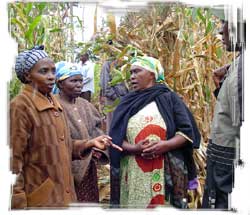CIMMYT E-News, vol 3 no. 8, August 2006
 Farmers of the village of Kathaka Kaome in Embu district near Mount Kenya are saying that quality protein maize (QPM) is as nutritious as Githeri—a local dish made from maize and beans.
Farmers of the village of Kathaka Kaome in Embu district near Mount Kenya are saying that quality protein maize (QPM) is as nutritious as Githeri—a local dish made from maize and beans.
At a farmer field day on 24 July 2006, Samuel Kinyua Mwitari, the chairperson of Nthambo Murimi Mwaro (Nthambo’s Best Farmer) Self-help Group, has turned out in his best pinstripe suit. He stands next to his plot of maize plants—with husks pulled back revealing mature, full, healthy cobs—to tell the 180 farmers present all they need to know about quality protein maize (QPM).
Five other farmers, including the Group’s Secretary, Susan Njeru, are also on hand to inform farmers from Kathaka Kaome and neighboring villages about the new maize and its nutritional benefits. “Personally, I won’t be planting any other maize!” she declares. “And I want to advise everybody to plant QPM for the betterment of their families.”
Embu is among the first four districts in Kenya’s Central Province to host QPM promotion trials. The districts lie on the moist upper and dry lower slopes of Mt. Kenya, where maize is a major dietary staple. Inhabitants boil whole dry kernels with beans to make githeri, a popular local dish. But the price of beans and other pulses has climbed steadily in recent years, and diets in poorer households are increasingly maize-based. Serious protein malnutrition is now common in weaning babies, whose staple is maize porridge.
Quality protein maize grain contains enhanced levels of the essential amino acids lysine and tryptophan, along with other characteristics that make more of its protein useful to humans or farm animals. It has 90% of the nutritive value of milk, and can stem or reverse protein malnutrition. Resource-poor farmers who cannot afford supplements can use QPM in swine or poultry feeds to increase the animals’ growth and productivity.
The QPM varieties being promoted—products of 30 years of research involving CIMMYT maize breeders and others—are indistinguishable from normal maize in appearance, and mill and store just as well. Does QPM taste better than normal maize? At the recent field day in Embu the farmers said they preferred the taste, texture, and appearance of githeri made with the QPM.
The Canadian International Development Agency (CIDA) is supporting the development and deployment of locally adapted QPM, in a project led by CIMMYT agronomist Dennis Friesen. “The Kenya Agricultural Research Institute has been our main partner in adapting QPM to local environments and identifying farmer-preferred cultivars,” says Friesen. “We are also working with the Catholic Relief Services, which has strong grassroots linkages, the Catholic Diocese of Embu, and the Kenya Ministry of Agriculture, to promote QPM on the ground.”
The QPM dissemination work fits the aims of the Catholic Diocese of Embu, according to CDE chief extension officer, John Namu Munene: “We at the diocese realize we have a responsibility to participate in efforts that improve the lives of our people.” Addressing farmers at the field day, he praised QPM: “Even without beans, with this maize your githeri is full of protein.”
Johnson Irungu, the Catholic Relief Services (CRS) officer overseeing the dissemination project, says he is happy with the acceptance of QPM among farmers, but is quick to add that seed availability will be critical to sustaining the momentum. The QPM trait is recessive—meaning that if the maize is planted close to non-QPM varieties and is fertilized by their pollen, the quality trait will be lost. Farmers must therefore buy certified QPM seed each season or avoid sowing nearby or at the same time as neighboring, non-QPM maize fields. Embu Self-Help Group members are well-versed in this special requirement and advise fellow farmers on how to preserve the trait. As Susan Njeru explained to a group of farmers: “If you want to recycle QPM you have to harvest the cobs that you will use for seed from the center of your field, and keep them separate.”
CIMMYT has supported two local seed companies, Western Seed Company and Freshco Ltd, with training in QPM seed production and quality assurance, essential for sustainability. They are producing seed of an extra-early, drought-tolerant, open-pollinated QPM variety and two QPM hybrids for sale starting in 2007. Both companies sent their representatives several hundred kilometers to Embu to attend the field day.
For more information contact Dennis Friesen (d.friesen@cgiar.org)
